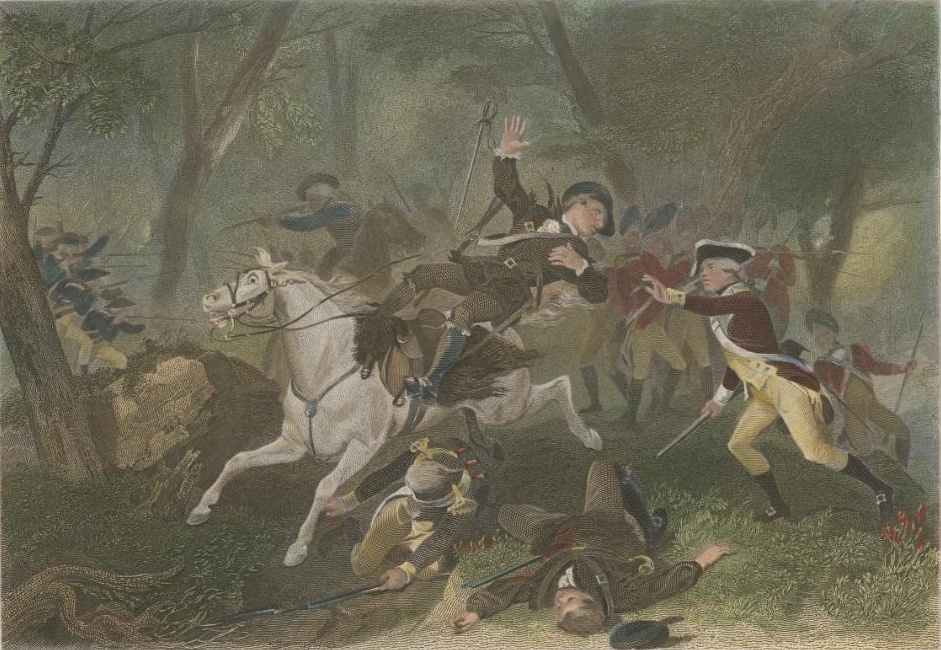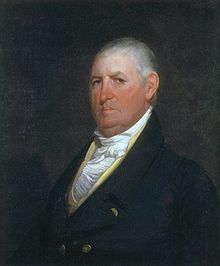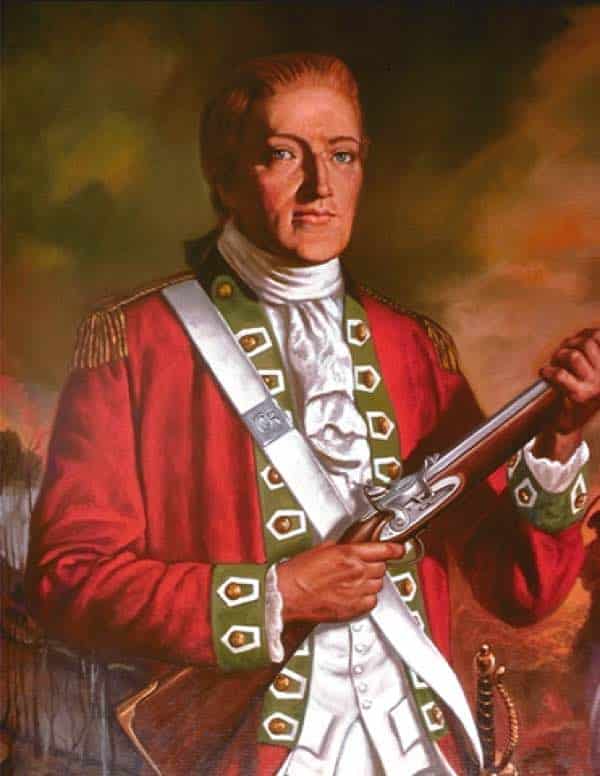The Battle of King's Mountain was a decisive victory for the Americans in South Carolina. The victory was a surprise to the British, who had won a series of battles prior to King's Mountain.

The victory cost Lord Cornwallis, one of his premier commanders in Major Patrick Ferguson (KIA), Loyalist support and a chance to invade North Carolina.
This battle would also be the war's largest all-American fight since it pitted the Patriot militia against the Loyalist militia.
Prelude to Battle
Major Patrick Ferguson was appointed Inspector of the Militia on May 22, 1780. His task was to march to the old Tryon County area, raise and organize Loyalist units from the Tory Population of the Carolina Backcountry, and protect the left flank of Lord Cornwallis' main body at Charlotte, North Carolina.
The Massacre at Waxhaws also stayed at the forefront of the American mind. The Patriots were itching to avenge their comrades by returning the favor to the British and giving them "Tarleton's Quarter," which was given to their friends by Banastre Tarleton.
Battle of Musgrove's Mill
On the morning of August 18, 1780, two hundred mounted Patriot partisans under the joint command of Colonels Isaac Shelby, James Williams, and Elijah Clarke prepared to raid a Loyalist camp at Musgrove's Mill, which controlled the local grain supply and guarded a ford of the Enoree River.
The next day, the battle took place.
The Patriots anticipated surprising a garrison of about an equal number of Loyalists, but a local farmer informed them that the Tories had recently been reinforced by about a hundred Loyalist militia and two hundred provincial regulars on their way to join British Major Patrick Ferguson.
The whole battle took perhaps an hour, and within that period, sixty-three Tories were killed, an unknown number wounded, and seventy were taken prisoner.
The Patriot casualties were minor, with only four dead and twelve wounded.
The Pursuit of Colonel Isaac Shelby

After the Battle of Musgrove's Mill, Major Patrick Ferguson and his men began to pursue to Colonel.
Shortly after Musgrove's Mill, the men learned of Horatio Gates's disaster at the Battle of Camden. Their victory showed that the British would have a difficult time holding the South Carolina backcountry, but the loss at Camden shattered the Continental Army's morale so much that it hurt recruiting.
Shelby and his Overmountain Men crossed back over the Appalachian Mountains and retreated back into the territory of the Watauga Association at Sycamore Shoals.
By the next month, Colonels Shelby, John Sevier, and Charles McDowell and their 600 Overmountain Men had combined forces with Colonel William Campbell and his 400 Virginia men.
Patrick Ferguson and his men had already marched towards Shelby and into the Appalachian Mountains.
He established a camp at Gilbert Town, North Carolina, and issued a challenge to the Patriot leaders to lay down their arms or he would "lay waste to their country with fire and sword."
The Patriot militia leaders responded to this threat by agreeing to attack Ferguson.
Sycamore Shoals
Patriot leaders made contact with Virginia militia leader William Campbell and asked him to join them at Sycamore Shoals.
Campbell agreed and asked Benjamin Cleveland to bring his Wilkes County, North Carolina militia to the rendezvous. The detachments of Shelby, Sevier, and Campbell were met by 160 militiamen led by Charles McDowell and his brother Joseph.
Arthur Campbell, William's cousin, brought another 200 Virginians. This put the total at 1,100 volunteers that mustered at the rendezvous. These men were known as Overmountain Men and were very capable with their weapons.
They lived on the ridgeline of the Appalachian Mountains and were rough, loyal, and fiercely patriotic.
The movement of this many men in the backcountry and in Indian territory was made possible by the diplomatic efforts of Benjamin Cleveland's brother-in-law, Joseph Martin.
His efforts eased the tension, and the Overmountain Men were able to cross Roan Mountain and begin their march to King's Mountain.
Out of all the commanders, William Campbell was chosen as the primary commander, but they all agreed to act in council to command their combined army.
Ferguson's Plans

Two deserters of the patriot militia made it to Patrick Ferguson and informed him of the large body of militia advancing towards him.
Patrick Ferguson waited three days before moving and ordered a retreat to Lord Cornwallis and the British main forces in Charlotte. He sent a request to Cornwallis requesting more troops, but it would not arrive on time. He also tried to recruit more loyalists.
On October 4, the Patriot militia reached Ferguson's old camp at Gilbert Town. There, they met another 30 Georgia militiamen who were anxious for some action.
A couple of days later, they passed through Cowpens, South Carolina (Site of the future Battle of Cowpens), where they learned that Ferguson was east of them and heading towards Charlotte, North Carolina.
Instead of pushing forward to Cornwallis, Ferguson opted to send the Cornwallis a letter asking for reinforcements and set up camp on King's Mountain.
Kings Mountain is one of many rocky forested hills in upper Piedmont, near the border between North and South Carolina.
It is shaped like a footprint with the highest point at the heel, a narrow instep, and a broadly rounded toe. The Loyalists camped on a ridge west of Kings Pinnacle, the highest point on Kings Mountain.
Needing to hurry, the Patriot militia put 900 men on horseback and rode for Kings Mountain. They left immediately, marching through the night of the 6th and morning of the 7th, even though the rain never stopped.
By sunrise on the 7th, they forded the Broad River, fifteen miles from Kings Mountain. By early afternoon, they arrived and immediately surrounded the ridge and attacked
The Battle

Photo from campaign 1776
At about 3:00 p.m., Loyalist scouts detected movement in the woods on the northern side of Kings Mountain. At the same time, pickets on the mountain precipice opened a sporadic long-range fire against Shelby’s approaching column.
As this fire was developing, advanced elements of other northern militia columns from the Left Division ran up against loyalist pickets near the base of the northeast sector of the mountain, and a fitful firing also broke out there.
Loyalist drums were beaten, and Ferguson blew his whistle commands to order his Provincial Rangers (men raised in the colonies to fight for the British) to move rapidly to the southwest corner of the ridge to counter what Ferguson deemed to be the most serious threat.
As events would prove, he was correct about the threat about to engulf the narrow southwest plateau. In addition to the Provincial Rangers, his Loyalist militia included experienced men from District Ninety Six, South Carolinians Ferguson had enlisted and formed months earlier.
They were well prepared for battle, and Ferguson employed them skillfully. Moving around the southwest base of the mountain, Campbell’s rebel column was detected by a Loyalist who fired into approaching frontiersmen.
Realizing the element of surprise was lost, Campbell made a command decision to turn and assault the heights.
At nearly the exact same time, Major Winston’s mounted force reached its assigned position on the northeast side, blocking the only road off Kings Mountain. Winston’s men attacked from that position.
Because the assault commenced prematurely, Sevier’s following column became intermingled with Campbell’s and ended up widely divided.
All of Sevier’s 120 men would assault up the narrow southwest end of the mountain, and the unit as a whole retained some company integrity.
However, as the bulk of Sevier’s men deployed into their assigned sector on Campbell’s right (northeast), a large contingent broke off and ended up assaulting the mountain on Campbell’s left, between Campbell and Shelby farther to the northeast on the northern side of the ridge.

Because Campbell’s Right Division had not yet extended along the southern base of the mountain as planned, McDowell urged his 90 men to maneuver as quickly as possible around Campbell’s right.
Although most eventually reached their assigned position, some made the assault up the hill intermingled with Campbell’s column.
The result was that the first twenty minutes of the battle were carried out by the Right Division alone because none of the Left Division columns had yet achieved their assigned jump-off positions.
As Campbell’s Right Division approached the crest, Ferguson personally ordered his Provincial Rangers to launch a bayonet charge.
The impact created by a wave of glistening steel rushing downhill into Patriots approaching from below sent the rebels reeling. Officers wielding swords cut down several of the retreating frontiersmen.
Many of Campbell’s men took shelter behind rocks and trees, where they remained hidden. Near the bottom, Campbell and his officers rallied their shaken men and urged them back up the slope.
When Ferguson blew his whistle to recall his Provincial Rangers to the summit, his South Carolina militia who had accompanied the charge became confused and did not immediately rally as intended.
The reinforced Loyalist assaults in the southwest stripped away enough defenders from the northwest slope for Shelby’s men to gain ground there. Just as they neared the summit, however, Ferguson dispatched his bayonet-wielding forces into their ranks.
This time, the result was not what Ferguson intended. The mountain men absorbed the bayonet assault and scampered partway down the hillside.
Although their unit formations had been broken, the small pockets of men and scattered individual fighters created a swarming effect around the attackers. The tactical situation favored the partisan Patriots, who excelled in Indian-style fighting.
Confident in their abilities, they began working their way back up the rock-strewn wooded slope, small knots of men supporting one another as they inexorably crawled, trotted, and crouched their way toward the crest.
The smoke and confusion made it difficult for Ferguson to grasp what was happening immediately.
His Loyalists had been trained to fight in traditional linear European fashion. The unconventional battle that had suddenly erupted in their faces forced them to fight at a great disadvantage.
As they quickly discovered, their drill in massed formations and dependence upon bulk musket fire was useless against dispersed militia hiding behind trees and rocks, picking them apart with accurate small arms fire.
Near the southwestern tip of the summit, Campbell’s, Sevier’s, and Shelby’s men pressed into the British lines, where a bloody hand-to-hand struggle ensued. Meanwhile, the heights to the northeast were threatened by the arrival of the other Patriot columns.
Ferguson left Loyalist militia to defend the southwestern end of the ridge while he led his Provincial Rangers down the ridge (northeast) to address the new threat arriving in that sector.
It was approximately 3:30 p.m., and Ferguson was rushing to confront the arriving columns comprising the Left Division. The terrain there was especially difficult because the elevation was steeper and the vegetation denser than it was on the opposite flank.
The arriving American militiamen were exhausted after their grueling march through the swampy lowlands and had already experienced a fitful fight against Loyalist sentries near the base of the northern slope.
They had also formed under fire. Majors Winston and Chronicle formed and assaulted from the northeast, while Colonels Cleveland, Williams, and Lacey attacked along the northern slope.
The men clambered over the craggy rock-strewn slopes while the Loyalists poured volleys of fire into them from above. Southwest of Chronicle’s position (on his right), Colonels Cleveland, Williams, and Lacey guided their men up the slope.
Ferguson’s militia held the tactical advantage, lining the brow of the northern ridge while waiting for the enemy to close within killing range.
Just as it had on the other end of the mountain, the inherent difficulty of climbing and fighting dispersed the once tightly-packed Patriot advance. The frontiersmen maneuvered in small pockets and fired well-aimed shots into the defenders hovering above them.
On the summit, the Provincial Rangers launched another bayonet charge. Hambright’s men were struggling up the steep northeast slope when the charge fell upon them. A few minutes later, the Rangers withdrew while the Loyalist militia covered them from above.
In Cleveland’s sector, the Loyalists made only one other bayonet charge down the northern slope. The bloody work of the bayonet charges did nothing to dissuade the Patriots from their assault.
The heavy pressure against the northeast summit forced Ferguson to shuttle men to the embattled sector or risk having it overrun.
Like a large vice, the pressure slowly but surely crushed Ferguson’s position from every side. In the southwest corner of the ridge, dozens of frontiersmen from the Right Division finally reached the summit and began pushing Loyalist militia from their rocky strongholds along the crest. Elements of the Left Division began mounting the crest in the northern and northeastern sectors about the same time.
The tide of battle was turning decisively in favor of the Patriot militia. Ferguson’s position was now desperate. His surviving soldiers were being pressed into an ever-constricting mass, surrounded by a deadly enemy within a shrinking enclave on the northeast end of Kings Mountain. Constrained within his own formations, tents, and wagons, Ferguson had little room to maneuver.
His only option was to stand and die or assault and try to turn the tide. Blowing on his silver whistle, Ferguson ordered the Provincial Rangers to assault the enemy charging up the ridge from the southwest. He also ordered some mounted men to charge into the approaching enemy, but they could not do so because the Mountaineers picked them off too quickly.
Pressing forward, the swarming Patriots gained the upper hand quickly, picking off Tories milling about on the open plateau before them. The demise of the Provincial Rangers signaled the end of Ferguson’s now demoralized command, which was now completely surrounded and running out of ammunition.
Amidst the smoke and confusion, Ferguson was killed by musket fire. Realizing there was no further hope in fighting, the surviving Tories began surrendering and begging for the quarter. As is always true in close-quarter fighting, the killing continued for some time until violent passions subsided and control was established.
The Tory prisoners were marched first to Gilbert Town and then to Hillsboro, North Carolina. Many escaped along the way. Nine were hanged for committing heinous crimes, an act that perpetuated the cycle of retribution.
Following the fighting, the victorious frontiersmen disbanded and returned to their homes for the winter, while the British retreated to winter quarters around Winnsboro, South Carolina.
Fallout
Kings Mountain was a pivotal moment in the history of the American Revolution. Coming after a series of disasters and humiliations in the Carolinas, the fall of Charleston and capture of the American army there, the destruction of another American army at the Battle of Camden, and the Waxhaws Massacre, the surprising decisive victory at Kings Mountain was a great boost to Patriot morale.
The Tories of the Carolina backcountry were broken as a military force. Additionally, the destruction of Ferguson's command and the looming threat of the Patriot militia in the mountains caused Lord Cornwallis to cancel his plans to invade North Carolina; he instead evacuated Charlotte and retreated to South Carolina.
He would not return to North Carolina until early 1781 when he was chasing Nathanael Greene after the Americans had dealt British forces another defeat at the Battle of Cowpens.

Online Resources
- Battle of King's Mountain Eyewitness Accounts
- Wikipedia - King's Mountain
- King's Mountain National Park
- Death of a Patriot at Kings Mountain
- William Campbell: the Expedition to and Battle of King's Mountain
- Revolutionary War Battles
- American Revolutionary War
- Revolutionary War Timeline
- Return To The History Junkie Homepage
